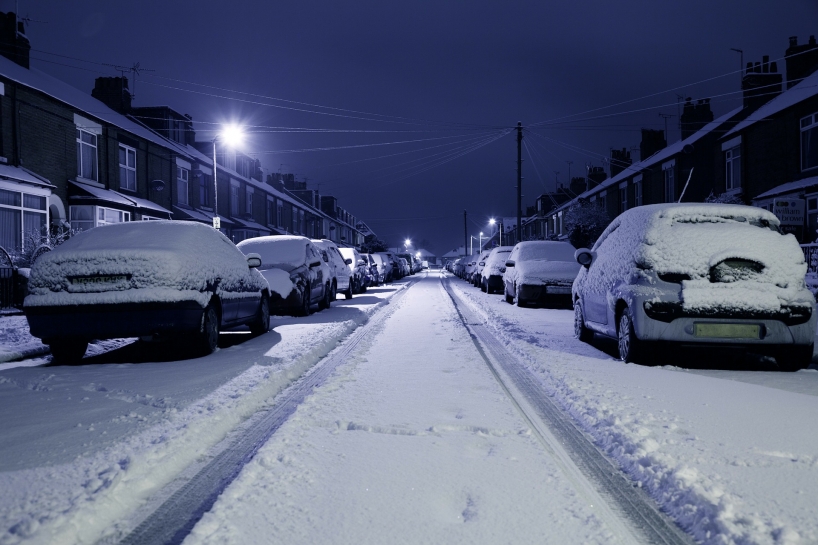
January 14th, 2019 by
Breakdowns and accidents are much more likely in winter. In fact, you’re over 20% more likely to get in an accident in winter time! The combination of bad weather, darkness, and low temperatures make it hard for both you and your car, and they mean you need to take a bit of extra care in the winter. These winter driving tips will help you stay safe on the roads in winter time, and are especially useful for young or inexperienced drivers!
Check Your Tyres More Often
 A common myth is that you should underinflate your tyres during winter. However, this will actually increase the risk of getting in an accident! Your tyres are designed to work best at your manufacturer’s recommended pressure no matter what season it is, and if there’s any time you want your tyres to be working at their best, it’s winter! You should check your tyres more often in winter to make sure they’re at a safe pressure. What’s also important is making sure that your tyre treads are at a safe depth. Make sure you’ve got around 3mm tyre tread on your tyres to help your car grip the roads on those winter evenings.
A common myth is that you should underinflate your tyres during winter. However, this will actually increase the risk of getting in an accident! Your tyres are designed to work best at your manufacturer’s recommended pressure no matter what season it is, and if there’s any time you want your tyres to be working at their best, it’s winter! You should check your tyres more often in winter to make sure they’re at a safe pressure. What’s also important is making sure that your tyre treads are at a safe depth. Make sure you’ve got around 3mm tyre tread on your tyres to help your car grip the roads on those winter evenings.
Clean Your Windscreen Inside and Out
 We’ve all experienced it at least once; you’re late for work on a cold winter morning, you jump into your car, get ready to set off, and you’re stopped in your tracks by a windscreen becoming a thick bank of fog! To help reduce this, you should make a habit of cleaning your windscreen more often in winter. This is because the fog on your windscreen is caused by condensation, which occurs when the warm, moist air from your breath comes into contact with your cold windscreen. When your windscreen is dirty, this condensation has more surface area to form on as it can cling onto the tiny particles of dirt on your windscreen. This means you’ll end up with worse fogging on your windscreen that’s harder to clear! If your windscreen is regularly cleaned inside and out, you’ll find it doesn’t fog up anywhere near as badly in the morning as there are less dirt particles for condensation to cling onto. You’ll still notice some condensation, but it won’t be anywhere near as bad and you should be able to clear it away by setting your car’s vents to fresh air mode (rather than re-circulate mode).
We’ve all experienced it at least once; you’re late for work on a cold winter morning, you jump into your car, get ready to set off, and you’re stopped in your tracks by a windscreen becoming a thick bank of fog! To help reduce this, you should make a habit of cleaning your windscreen more often in winter. This is because the fog on your windscreen is caused by condensation, which occurs when the warm, moist air from your breath comes into contact with your cold windscreen. When your windscreen is dirty, this condensation has more surface area to form on as it can cling onto the tiny particles of dirt on your windscreen. This means you’ll end up with worse fogging on your windscreen that’s harder to clear! If your windscreen is regularly cleaned inside and out, you’ll find it doesn’t fog up anywhere near as badly in the morning as there are less dirt particles for condensation to cling onto. You’ll still notice some condensation, but it won’t be anywhere near as bad and you should be able to clear it away by setting your car’s vents to fresh air mode (rather than re-circulate mode).
Clean Your Car More Regularly
Through the winter, you’ll want to wash your car much more regularly. There are two main reasons for this – the first and most obvious is to clean up all the sludge and dirt that seems to be everywhere in winter, so your car will always look great. However, there’s another, more important reason you should clean your car. During winter, there’ll be a lot of salt spread onto the roads. Salt is an essential part of winter road maintenance, but it can cause major problems for your car if you’re not careful. It clings to the underside of your car, where it quickly starts to corrode the important parts underneath your car. It’ll also damage the sealants on your car’s bodywork, so it can cause rusting if you don’t clean it off. You should wash your car every few weeks, starting with a thorough snow foam pre-wash to lift that salt and grit off your car, and finishing with a layer of hard wax for maximum protection.
Take Care of Your Battery
 Winter is hard on car batteries for two reasons. The first is that you’ll have your heating and lights on most of the time, so your battery has much more work to do. The second is that cold weather can actually affect the chemical processes inside a battery, so your battery will hold less charge. As a result of these things, flat batteries are by far the most common cause of winter breakdowns! If your battery is a few years old, you can protect it by being a bit more careful in how you start your car in winter. Before you start your car on a cold morning, make sure all your lights, air vents, and any other electronics are turned off. Then turn the ignition, but don’t actually turn your engine over for a couple of seconds. This will allow all the electronics to turn on before you start your engine, which will reduce the load on your battery and help protect it.
Winter is hard on car batteries for two reasons. The first is that you’ll have your heating and lights on most of the time, so your battery has much more work to do. The second is that cold weather can actually affect the chemical processes inside a battery, so your battery will hold less charge. As a result of these things, flat batteries are by far the most common cause of winter breakdowns! If your battery is a few years old, you can protect it by being a bit more careful in how you start your car in winter. Before you start your car on a cold morning, make sure all your lights, air vents, and any other electronics are turned off. Then turn the ignition, but don’t actually turn your engine over for a couple of seconds. This will allow all the electronics to turn on before you start your engine, which will reduce the load on your battery and help protect it.
Plan Your Routes More Carefully
 Make sure you plan your winter driving routes to take you down main roads or motorways. These are given priority when it comes to gritting, so they’re much more likely to be kept clear. If your usual route to work involves a shortcut through some back lanes, you might want to avoid them in winter as these roads are rarely kept clear. If this is the case, set off a little earlier in the morning to make up for the slightly longer journey – it’s annoying but much, much safer! You should also make sure to check traffic news online before you set off. Visit the Highways England website or check Twitter for the latest traffic issues so you can plan your journey accordingly. If you have a satnav or a phone with real-time traffic information, this will also help you avoid any major delays!
Make sure you plan your winter driving routes to take you down main roads or motorways. These are given priority when it comes to gritting, so they’re much more likely to be kept clear. If your usual route to work involves a shortcut through some back lanes, you might want to avoid them in winter as these roads are rarely kept clear. If this is the case, set off a little earlier in the morning to make up for the slightly longer journey – it’s annoying but much, much safer! You should also make sure to check traffic news online before you set off. Visit the Highways England website or check Twitter for the latest traffic issues so you can plan your journey accordingly. If you have a satnav or a phone with real-time traffic information, this will also help you avoid any major delays!
Comments
Leave a reply
Your e-mail address will not be published. All fields are required


